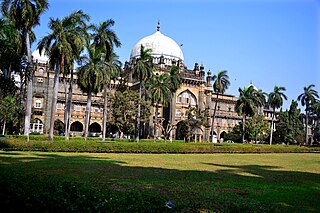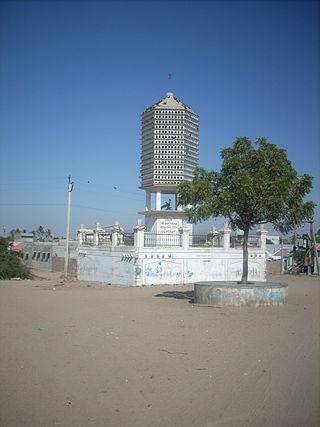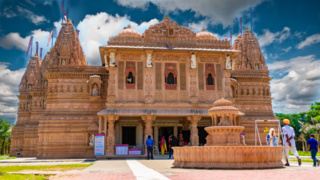
MacMurdo's Bungalow is a bungalow in Anjar town of Kutch district (Kachchh), Gujarat, India. It was built in 1818 by James MacMurdo, the first political resident of the British East India Company to Cutch State during his stay in Anjar. [1]

MacMurdo's Bungalow is a bungalow in Anjar town of Kutch district (Kachchh), Gujarat, India. It was built in 1818 by James MacMurdo, the first political resident of the British East India Company to Cutch State during his stay in Anjar. [1]
MacMurdo was interested in local customs and language and was impressed by local wall painting art. When he built the bungalow in Anjar, he invited local artists for wall paintings. The paintings have themes from the Ramayana such as the war between Ram and Ravana, the burning of Lanka, Sita in Ashok Vatika. Other paintings are associated with Krishna such as the raising of Govardhan Hill and Krishna and Gopi. There are also paintings of birds, plants and flowers. It is said that these paintings were created by Muslim artisans. The bungalow was formerly the Deputy Collector's Office. It is now State Protected Monument (S-GJ-46) due to these paintings but is in a neglected condition. [1] [2]

Kalaburagi, formerly known as Gulbarga, is a city in the Indian state of Karnataka. It is the administrative headquarters of the Kalaburagi district and is the largest city in the region of North Karnataka (Kalyana-Karnataka). Kalaburagi is 568 km north of the state capital city of Bangalore. It was incorporated into the newly formed Mysore State through the States Reorganisation Act in 1956.

Chhatrapati Shivaji Maharaj Vastu Sangrahalaya, (CSMVS) originally named Prince of Wales Museum of Western India, is a museum in Mumbai (Bombay) which documents the history of India from prehistoric to modern times.

Kutch district, officially spelled Kachchh, is a district of Gujarat state in western India, with its headquarters (capital) at Bhuj. Covering an area of 45,674 km2, it is the largest district of India. The area of Kutch District is larger than the entire area of states like Haryana (44,212 km2) and Kerala (38,863 km2). The population of Kutch is about 2,092,371. It has 10 talukas, 939 villages and 6 municipalities. The Kutch district is home to the Kutchi people who speak the Kutchi language.

Dwarka is a town and municipality of Devbhumi Dwarka district in the state of Gujarat. It is located on the western shore of the Okhamandal Peninsula on the right bank of the Gomti river at the mouth of the Gulf of Kutch facing the Arabian Sea.

Anjar is a town, township and municipality of the Kachchh district (Kutch)in the state of Gujarat, India. Founded in 650 AD, Anjar is a culturally diverse town of historic importance in the region. It is home to several historic religious temples, including the Jesal-Toral Shrines built in honour of a fourteenth century couple, whose lives inspired works of art and cinema. The town was devastated by several earthquakes, including the 1819 Rann of Kutch earthquake and 2001 Gujarat earthquake. In recent years, Anjar has become a hub of manufacturing activity.

Palanpur is a city and a municipality of Banaskantha district in the Indian state of Gujarat. Palanpur is the administrative headquarters of Banaskantha district. Palanpur is the ancestral home to an industry of Indian diamond merchants.

Sinugra is a village 7 kilometres (4.3 mi) from the town of Anjar, in the Anjar taluka of Kutch district in the Indian state of Gujarat.

Bandhani is a type of tie-dye textile decorated by plucking the cloth with the fingernails into many tiny bindings that form a figurative design. The term bandhani is derived from the Sanskrit verbal root bandh. Today, most Bandhani making centers are situated in Gujarat, Rajasthan, Sindh, Punjab region and in Tamil Nadu where it is known as Sungudi. It is known as chunri in Pakistan. Earliest evidence of Bandhani dates back to Indus Valley civilization where dyeing was done as early as 4000 B.C. The earliest example of the most pervasive type of Bandhani dots can be seen in the 6th century paintings depicting the life of Buddha found on the wall of Cave 1 at Ajanta. Bandhani is also known as Bandhej Saree, Bandhni, Piliya, and Chungidi in Tamil and regional dialects. Other tying techniques include Mothra, Ekdali and Shikari depending on the manner in which the cloth is tied. The final products are known with various names including Khombi, Ghar Chola, Patori and Chandrokhani.

Raghunath Temple is a Hindu temple located in Jammu in the Indian union territory of Jammu and Kashmir. It consists of a complex of seven Hindu shrines. Raghunath Temple was constructed by the first Dogra ruler Maharaja Gulab Singh in the year 1835 and later his son Maharaja Ranbir Singh got it completed in the year 1860 During Dogra rule. The temple has many gods in its complex of shrines, but the presiding deity is Rama – also known as Raghunath, an Avatar of Vishnu. All the spiral-shaped towers have gold plated spires. The niches in the walls of the shrines are decorated with 300 well-crafted icons of gods and goddesses including those of Surya and Shiva, but most are particularly related to the life stories of Rama and Krishna. The paintings in the 15 panels of the main shrine are based on themes from Ramayana, Mahabharata, and Bhagavad Gita. The temple premises include a school and a library that preserves over 6,000 manuscripts in many Indian languages, with a notable collection of Sarada script Sanskrit manuscripts.

The Sun Temple of Modhera is a Hindu temple dedicated to the solar deity Surya located at Modhera village of Mehsana district, Gujarat, India. It is situated on the bank of the river Pushpavati. It was built after 1026-27 CE during the reign of Bhima I of the Chaulukya dynasty. No worship is offered now and is protected monument maintained by Archaeological Survey of India. The temple complex has three components: Gūḍhamanḍapa, the shrine hall; Sabhamanḍapa, the assembly hall and Kunḍa, the reservoir. The halls have intricately carved exterior and pillars. The reservoir has steps to reach the bottom and numerous small shrines.
Vadnagar is a town and municipality in the Mehsana district of the state of Gujarat in India. It just about 35 km from Mehsana city. Its ancient names include Anartapura and Anandapura. It was a Buddhist location visited by Xuanzang in 640 C.E. Historian and archaeologist Alexander Cunningham has identified Anandapura with the town of Vadnagar. Vadnagar is also the birthplace of Narendra Modi, the current Prime Minister of India.

Roghan painting is an art of cloth printing practiced in Gujarat, Peshawar and Sindh. In this craft, paint made from boiled castor oil or linseed oil and vegetable dyes is laid down on fabric using a stylus.

Bhadresar or Bhadreshwar is a village in Mundra Taluka, Kutch district of Gujarat, India. It is about 27 km from Taluka headquarters Mundra and barely a kilometer away from the seashore.

Cutch, also spelled Kutch or Kachchh and also historically known as the Kingdom of Kutch, was a kingdom in the Kutch region from 1147 to 1819 and a princely state under British rule from 1819 to 1947. Its territories covered the present day Kutch region of Gujarat north of the Gulf of Kutch. Bordered by Sindh in the north, Cutch State was one of the few princely states with a coastline.

The Cutch Agency was one of the agencies of British India. The appointed Political Agent looked after only one territory, that of the princely state of Cutch, which had a surface of 19,725 square kilometres (7,616 sq mi), not including the Rann of Kutch.
Anjar is one of the 182 Legislative Assembly constituencies of Gujarat state in India. It is numbered as 4-Anjar.
Gandhidham is one of the 182 Legislative Assembly constituencies of Gujarat state in India. It is part of Kachchh district and is reserved for candidates belonging to the Scheduled Castes and was created after the 2008 delimitation, and is numbered as 5-Gandhidham.
Captain James MacMurdo was the first political resident of British East India Company to Cutch State. He played important role in bringing kutchh under British suzerainty.

The "Kamangiri art" or Kamangiri bhint chitro is a form of mural painting commissioned primarily in Kutch region of Indian state of Gujarat as well as some regions of Pakistan.
Vithalbhai Haveli is a haveli (mansion) in Vaso, Kheda district, Gujarat, India. It was built in late 19th century. It has four floors with beautifully carved wooden pillars, window frames, beams, ceilings and doors.